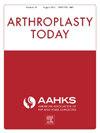体重指数增加与初次全膝关节置换术费用增加相关,不包括再入院和并发症
IF 2.1
Q3 ORTHOPEDICS
引用次数: 0
摘要
参与替代支付模式的外科医生可能会在照顾高成本患者时遇到财务障碍。虽然先前的研究显示了身体质量指数(BMI)与全膝关节置换术(TKA)成本之间的关系,但这个问题尚未使用具有全国代表性的数据集的最新数据进行检查。我们试图使用最近的数据来评估TKA中BMI和成本之间的关系。方法查询2016-2022年PINC人工智能医疗数据集,查找当前程序术语代码27447标识的主要tka。收集基线患者人口统计、特征和结果。患者费用包括指数和从手术开始的90天期间费用。一个多变量广义线性模型估计了8个BMI类别(WHO BMI类别,BMI >;40分为BMI 40-45、BMI 45-50和BMI >;50)的患者成本,一个线性回归模型评估了BMI对成本的影响。两个模型都控制了年龄、性别、付款人、种族、民族和Elixhauser合并症指数。结果共纳入原发性tka 24,064例。患者特征为年龄(平均68岁,SE 0.06)、性别(62.3%为女性)、付款人(63.8%为Medicare)、种族(88.6%为白人)、种族(3.1%为西班牙裔)和Elixhauser合并症指数(平均2.07,SE 0.01)。平均BMI为32.0 (SE 0.1),平均指数和90天成本分别为14,051±32.6美元和17,377±107.3美元。预测患者指数和90天费用在BMI >;50.0类别中均最高,分别为15,555美元和20,716美元。预测指数和90天成本分别在25.0-29.9(13,765美元)和18.5(16,403美元)类别中最低。多因素分析显示,患者指数和90天费用增加了23.20美元(P <;.001)和48.10美元(P <;BMI每增加1点,分别为0.01)。结论较高的患者BMI与原发性TKA的指数升高和90天发作成本相关。利益相关者可以考虑将这些信息纳入捆绑支付模式和其他基于价值的报销模式。本文章由计算机程序翻译,如有差异,请以英文原文为准。
Increased Body Mass Index is Associated With Increased Cost for Primary Total Knee Arthroplasty Exclusive of Readmissions and Complications
Background
Surgeons participating in alternative payment models may encounter financial disincentives in caring for high-cost patients. While prior studies have shown a relationship between body mass index (BMI) and cost in total knee arthroplasty (TKA), this question has not been examined using recent data in a nationally-representative dataset. We sought to use recent data to assess the relationship between BMI and cost in TKA.
Methods
We queried the 2016-2022 PINC AI Healthcare Dataset for primary TKAs identified by the Current Procedural Terminology code 27447. Baseline patient demographics, characteristics, and outcomes were gathered. Patient costs included index and 90-day period costs starting from the surgical encounter. A multivariate generalized linear model estimated patient costs across eight BMI categories (WHO BMI categories, with BMI >40 grouped into BMI 40-45, BMI 45-50, and BMI >50), and a linear regression model assessed the effect of BMI on costs. Both models controlled for age, sex, payer, race, ethnicity, and Elixhauser Comorbidity Index.
Results
A total of 24,064 primary TKAs were included. Patient characteristics were age (mean 68 years, SE 0.06), sex (62.3% female), payer (63.8% Medicare), race (88.6% white), ethnicity (3.1% Hispanic), and Elixhauser Comorbidity Index (mean 2.07, SE 0.01). The mean BMI was 32.0 (SE 0.1), with mean index and 90-day costs of $14,051 ± $32.6 and $17,377 ± 107.3, respectively. Predicted patient index and 90-day costs were both highest in the BMI >50.0 category at $15,555 and $20,716, respectively. Predicted index and 90-day costs were lowest in the 25.0-29.9 ($13,765) and <18.5 ($16,403) categories, respectively. The multivariate analysis showed that patient index and 90-day costs increased by $23.20 (P < .001) and $48.10 (P < .01), respectively, per one-point increase in BMI.
Conclusions
Higher patient BMI is associated with increased index and 90-day episodic costs for primary TKA. Stakeholders may consider incorporating this information in bundled payment models and other value-based reimbursement models.
求助全文
通过发布文献求助,成功后即可免费获取论文全文。
去求助
来源期刊

Arthroplasty Today
Medicine-Surgery
CiteScore
2.90
自引率
0.00%
发文量
258
审稿时长
40 weeks
期刊介绍:
Arthroplasty Today is a companion journal to the Journal of Arthroplasty. The journal Arthroplasty Today brings together the clinical and scientific foundations for joint replacement of the hip and knee in an open-access, online format. Arthroplasty Today solicits manuscripts of the highest quality from all areas of scientific endeavor that relate to joint replacement or the treatment of its complications, including those dealing with patient outcomes, economic and policy issues, prosthetic design, biomechanics, biomaterials, and biologic response to arthroplasty. The journal focuses on case reports. It is the purpose of Arthroplasty Today to present material to practicing orthopaedic surgeons that will keep them abreast of developments in the field, prove useful in the care of patients, and aid in understanding the scientific foundation of this subspecialty area of joint replacement. The international members of the Editorial Board provide a worldwide perspective for the journal''s area of interest. Their participation ensures that each issue of Arthroplasty Today provides the reader with timely, peer-reviewed articles of the highest quality.
 求助内容:
求助内容: 应助结果提醒方式:
应助结果提醒方式:


